Related Research Articles
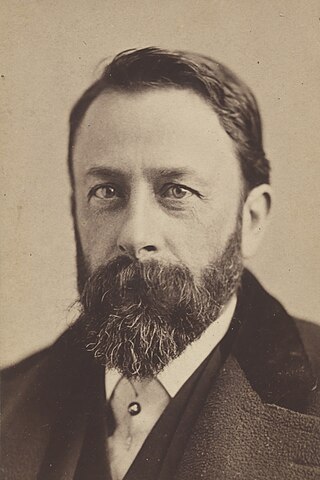
Albert Bierstadt was a German American painter best known for his lavish, sweeping landscapes of the American West. He joined several journeys of the Westward Expansion to paint the scenes. He was not the first artist to record the sites, but he was the foremost painter of them for the remainder of the 19th century.

Mark George Tobey was an American painter. His densely structured compositions, inspired by Asian calligraphy, resemble Abstract expressionism, although the motives for his compositions differ philosophically from most Abstract Expressionist painters. His work was widely recognized throughout the United States and Europe. Along with Guy Anderson, Kenneth Callahan, Morris Graves, and William Cumming, Tobey was a founder of the Northwest School. Senior in age and experience, he had a strong influence on the others; friend and mentor, Tobey shared their interest in philosophy and Eastern religions. Similar to others of the Northwest School, Tobey was mostly self-taught after early studies at the Art Institute of Chicago. In 1921, Tobey founded the art department at The Cornish School in Seattle, Washington.
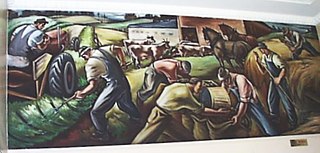
The Northwest School was an American art movement established in the Seattle area. It flourished in the 1930s–40s.

Morris Cole Graves was an American painter. He was one of the earliest Modern artists from the Pacific Northwest to achieve national and international acclaim. His style, referred to by some reviewers as Mysticism, used the muted tones of the Northwest environment, Asian aesthetics and philosophy, and a personal iconography of birds, flowers, chalices, and other images to explore the nature of consciousness.
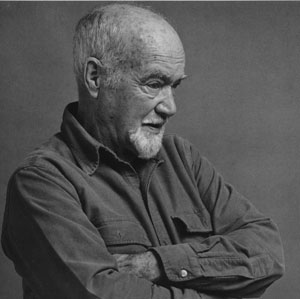
Kenneth Callahan (1905–1986) was an American painter and muralist who served as a catalyst for Northwest artists in the mid-20th century through his own painting, his work as assistant director and curator at the Seattle Art Museum, and his writings about contemporary art. Born in Eastern Washington and largely self-taught as an artist, Callahan was committed to an art that went beyond the merely illustrative. He enrolled at the University of Washington in 1924 but did not stay long. He traveled widely, absorbing influences from the different countries and cultures he experienced. His talent was recognized early; his work was included in the first Whitney Biennial exhibition in 1933 and he went on to a distinguished painting career. Callahan is identified as one of the Northwest Mystics – along with Guy Anderson, Morris Graves, and Mark Tobey, who shared a muted palette and strong interest in Asian aesthetics.
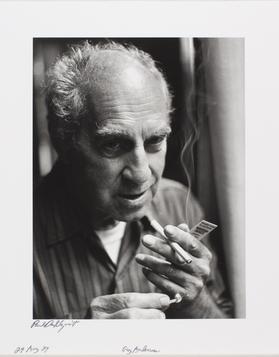
Guy Anderson was an American artist known primarily for his oil painting who lived most of his life in the Puget Sound region of the United States. His work is in the collections of numerous museums including the Seattle Art Museum, the Tacoma Art Museum, and the Metropolitan Museum of Art. He has been called "Perhaps the most powerful artist to emerge from the Northwest School".
Joe Goode is an American artist who attended the Chouinard Art Institute in Los Angeles from 1959–1961. Born in Oklahoma City, Oklahoma, Goode made a name for himself in Los Angeles through his cloud imagery and milk bottle paintings which were associated with the Pop Art movement. The artist is also closely associated with Light and Space, a West coast movement of the early 1960s. He currently creates and resides in Los Angeles, California.

Hans Gustav Burkhardt was a Swiss-American abstract expressionist artist.

Helmi Dagmar Juvonen was an American artist active in Seattle, Washington. Although she worked in a wide variety of media, she is best known for her prints, paintings, and drawings. She is associated with the artists of the Northwest School.

Robert H. Hudson is an American visual artist. He is known for his funk art assemblage metal sculptures, but he has also worked in painting and printmaking.
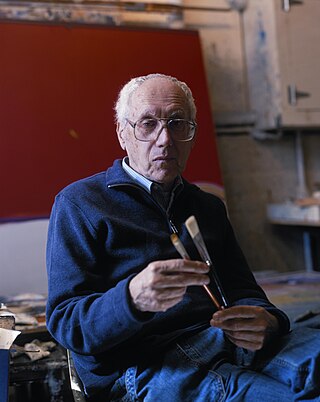
Raimonds Staprans is an artist and playwright both in the United States and his native Latvia. Staprans was born in 1926 in Riga, Latvia. He now lives in San Francisco, California, with his wife, scientist Ilona Staprāns. He has two daughters, Maretta Staprāns-Barlow and Alda Staprāns-Mednis.

Francis de Erdely was a Hungarian-American artist who was renowned in Europe and the United States for his powerful figure paintings and drawings as well as for his teaching abilities.
Leo Valledor (1936–1989) was a Filipino-American painter who pioneered the hard-edge painting style. During the 1960s he was a member of the Park Place Gallery in Soho, New York City, which exhibited many influential and significant artists of the period. He was a leader of the minimalist movement in the 1970s.
Lawrence Calcagno was a San Francisco Bay area abstract expressionist painter. He described his artistic motivation in the following words

Wesley Conrad Wehr was an American paleontologist and artist best known for his studies of Cenozoic fossil floras in western North America, the Stonerose Interpretive Center, and as a part of the Northwest School of art. Wehr published two books with University of Washington Press that chronicled his friendships with artists and scientists.

Jay Steensma (1941–1994), also known as J. Steensma, was an American artist, primarily a painter, sometimes described by reviewers as a later-day exponent of the Northwest School of artists. He was known for his extremely prolific output, and, at times, unusual media. Chalices, snakes, houses, clouds, birds, and fish were frequent subjects in his work. He was one of the more successful artists in the Pacific Northwest in the 1980s and 90s, but had longstanding health problems, and died in Seattle at age 52.
Neil Meitzler (1930–2009) was an American painter, well known in the Pacific Northwest for his landscapes and scenes of nature, rendered in a distinctive, modern style. He is often associated with the 'Northwest School' art movement.

Fay Chong (1912–1973) was a Chinese-American artist and educator, well known for his printmaking and watercolor painting. He was also known for his activities as an arts organizer, arts educator and WPA-era artist. Chong was active in the Pacific Northwest.

Frank Sumio Okada (1931–2000) was an American Abstract Expressionist painter, mainly active in the Pacific Northwest. His mature style often featured brightly colored, off-kilter geometric shapes done in large format, including round canvasses; subtly elaborate brushwork suggested the influence of both traditional Asian art and the "mystics" of the Northwest School. His later work at times used symbolic shapes which more directly evoked his Nisei heritage and the years he spent in detention camps with his family during World War II.

Robert Bruce Inverarity was an American artist, art educator, museum director, author, and anthropologist. He was the Washington State Director of the Federal Arts Project from 1936 to 1939 and the Washington Arts Project from 1939 to 1941, working with many noted Pacific Northwest artists. Fascinated with the Indian tribes of the Northwest from early youth, he amassed a major collection of North Pacific Coast Native art and authored several works on the subject.
References
- 1 2 3 4 5 6 "WINDSOR UTLEY". Foster / White Gallery. Retrieved 2010-02-26.
- ↑ "WWII Civilian Public Service Camp Photographs". Lewis & Clark College. Retrieved 2010-02-26.
- ↑ "Windsor Utley papers, 1951-1959". Smithsonian archives of American art. Retrieved 2010-02-26.
- ↑ "Mark Tobey to Windsor Utley, 1959". Smithsonian archives of American art. Retrieved 2010-02-26.
- 1 2 "Guide to the Windsor Utley Papers 1927-1990". University of Washington. Retrieved 2010-02-26.